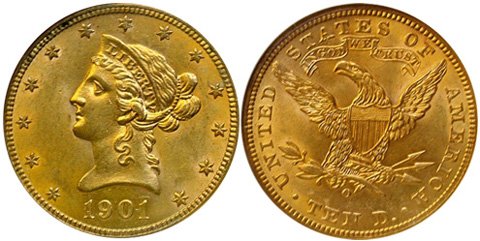Guide to U.S. Liberty Gold Eagles
The Liberty Head Gold Eagle was introduced in 1838 following a three decade hiatus in production for the ten dollar gold denomination. The new series featured an updated design by Christian Gobrecht as well as a reduced weight and diameter. Production would take place across five different mint facilities until the conclusion of the series in 1907. During this span, mintages ranged from a mere 100 pieces to multiple millions, creating both rarities and common issues. The series also contains a number of conditional rarities, as extensive circulation sometimes left few or no surviving examples in mint state grades.

After the production of the eagle was suspended in 1804, the half eagle served as the largest gold denomination and became the coin of choice for large or overseas transactions. This would remain the case until the early 1830’s when the rising price of gold made the melt value of the half eagles and quarter eagles higher than their respective face values. The Coinage Act of 1834 would bring things back into balance by realigning the precious metal content and face values across all gold denominations. This would also clear the way for the reintroduction of the eagle as the highest circulating denomination.
The design for the Liberty Gold Eagle was created by Christian Gobrecht. He was serving as the Assistant Engraver of the United States Mint, but in time he would ascend to the role of Chief Engraver. He had been responsible for the Liberty Seated design, which was utilized across all silver denominations of his era. Likewise, the design he created for the eagle would later be adopted for the remaining gold denominations. Gobrecht’s designs would bring a measure of uniformity across United States coinage, which would endure for many decades.
The Liberty Eagle features the head of Liberty facing left. She wears a coronet inscribed LIBERTY and her hair is bound with a beaded ribbon. The date appears below and thirteen stars are placed evenly around. The obverse for eagles of 1838 and some of 1839 features a design known as “Type of 1838” differentiated by the pointed truncation of the neck and a partially covered ear. The modified form of the design known as “Type of 1840” would be used for the remaining coins of the series.
The reverse design depicts a bald eagle, grasping an olive branch in one talon and three arrows in the other. The eagle’s wings are spread, and a large shield is placed at its breast. The inscription UNITED STATES OF AMERICA is around and “TEN D.” is near the bottom rim, representing the first time the face value was included on the denomination. The reverse underwent two changes during the course of the series. The larger lettering used for the “Type of 1838” was reduced in size when the “Type of 1840” was introduced. In 1866, a scroll inscribed IN GOD WE TRUST was added above the head of the eagle. This motto had been added to the majority of denominations following the conclusion of the American Civil War.

